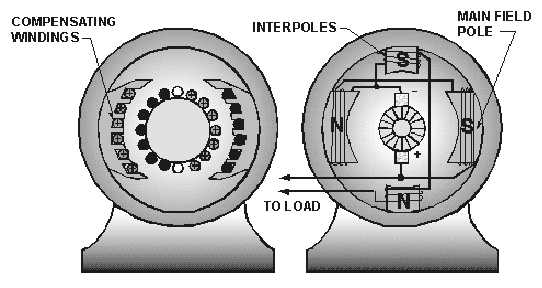1-10
Figure 1-9.—Compensating windings and interpoles.
Another way to reduce the effects of armature reaction is to place small auxiliary poles called
"interpoles" between the main field poles. The interpoles have a few turns of large wire and are connected
in series with the armature. Interpoles are wound and placed so that each interpole has the same magnetic
polarity as the main pole ahead of it, in the direction of rotation. The field generated by the interpoles
produces the same effect as the compensating winding. This field, in effect, cancels the armature reaction
for all values of load current by causing a shift in the neutral plane opposite to the shift caused by
armature reaction. The amount of shift caused by the interpoles will equal the shift caused by armature
reaction since both shifts are a result of armature current.
Q12. What is the purpose of interpoles?
MOTOR REACTION IN A GENERATOR
When a generator delivers current to a load, the armature current creates a magnetic force that
opposes the rotation of the armature. This is called MOTOR REACTION. A single armature conductor is
represented in figure 1-10, view A. When the conductor is stationary, no voltage is generated and no
current flows. Therefore, no force acts on the conductor. When the conductor is moved downward (fig. 1-
10, view B) and the circuit is completed through an external load, current flows through the conductor in
the direction indicated. This sets up lines of flux around the conductor in a clockwise direction.

